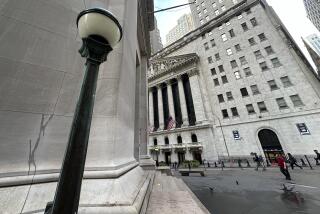Stocks slip after economic data, GE rating cut
Starved for months for upbeat news, Wall Street suddenly is getting some -- and investors are showing they havenât forgotten how to respond.
Stock prices surged Thursday, extending the rally that began on Tuesday as buyers snapped up shares still trading near their lowest levels in as much as a decade.
The Dow Jones industrial average jumped 239.66 points, or 3.5%, to 7,170.06, bringing the blue-chip indexâs three-day gain to 662 points, or 9.5%. Broader indexes also rose sharply.
Although many analysts remain fearful that the rebound in share prices could quickly give way to another sell-off in the now 16-month-old bear market, they say itâs a hopeful sign that investors arenât ignoring positive reports on the economy and individual companies.
âWe had some good news and the market ate it up,â said Steve Todd, editor of the Todd Market Forecast in Crestline, Calif.
The government reported that retail sales rose 0.7% in February, excluding depressed car sales. January sales using that same measure were revised to a 1.6% increase, from the 0.9% gain first reported.
The back-to-back gains suggested that consumer spending has stabilized after diving in the second half of 2008. Thatâs crucial for the economy because consumer outlays account for more than two-thirds of economic activity.
The February sales report âincreases the probability that this recession is starting to wind down,â said Bernard Baumohl, economist at the Economic Outlook Group in Princeton Junction, N.J.
Wall Streetâs turnaround began on Tuesday, when the Dow rocketed 379 points, or 5.8%, one day after falling to a fresh 12-year low.
The question is whether this will be just another brief rally in an ongoing slide. After the autumn market meltdown, the Dow rose nearly 20% from Nov. 21 to Jan. 2 as some investors stepped in, betting that the credit crisis was receding and that the recession would end early this year.
Instead, the market caved again in January and February amid a barrage of more bad news on the economy, and as investors grew impatient with the Obama administrationâs delays in devising a plan to get rotting loans off banksâ books. Treasury Secretary Timothy F. Geithner promised on Tuesday that details about the plan would be announced in the next two weeks.
Jeff Saut, chief investment strategist at brokerage Raymond James & Associates in St. Petersburg, Fla., noted that the marketâs recovery this week was âsharp and fast -- characteristic of bear-market rallies.â
He expects major indexes to bounce more than 20% from their lows reached on Monday. At that point, Saut said, many investors will have to decide whether thereâs enough hope about the economy to justify further buying, or whether the smarter move is to pull back and wait for lower prices.
The buying on Tuesday and again on Thursday was broad-based, a healthy sign. The Standard & Poorâs 500 index jumped 29.38 points, or 4.1%, to 750.74 on Thursday, bringing its three-day advance to 11%.
The Nasdaq composite gained 54.46 points, or 4%, to 1,426.10. Itâs up 12.4% since Monday.
The battered financial sector may be key to sustaining the improving mood, analysts say.
Bank stocks rallied Thursday after accounting rule makers promised Congress they would respond within three weeks to bankersâ demands to relax certain accounting rules for depressed mortgage securities.
The rules on so-called mark-to-market accounting have required banks to write down the value of many mortgage securities to levels the banks say are unrealistically low, in turn ravaging their balance sheets.
Any relaxation of the rules could take some financial pressure off struggling banks, analysts said. That helped drive up bank shares across the board. JPMorgan Chase rose $2.80 to $23.20; Wells Fargo jumped $2.07 to $13.95.
Bank of America surged 92 cents to $5.85, a gain of 19%. In a speech, BofA Chief Executive Ken Lewis reiterated that he didnât expect the bank to need more government financial aid.
Wall Street also was buoyed after General Motors said it wouldnât need the $2 billion in new federal loans the firm had expected to request this month. GMâs shares rose 32 cents to $2.18.
General Electric soared $1.08 to $9.57. The companyâs credit rating was downgraded to AA-plus from the coveted AAA grade by Standard & Poorâs, but some investors had expected worse given the companyâs struggles with its huge financial-services unit, GE Capital.
Although market bulls say savvy investors finally are jumping in to pick up bargains with key indexes down by more than 50% from their 2007 all-time highs, thereâs another force fueling the advance: Some âshort sellers,â who bet on falling prices, are buying to close out their bets.
In a short sale a trader borrows stock from a brokerage and sells it, expecting the price to decline. If the bet is correct the trader can buy new shares at a lower price later, repay the lent stock, and pocket the difference between the sale price and the repurchase price.
Once stocks begin to turn up, short sellers often rush in to close out their trades. That can make for explosive rallies.
Many Wall Street pros say a jump in short-selling in recent months added to conditions that had left the market overdue for a bounce.
âYou were coming from such a depressed level -- it was like a tinderbox waiting for a spark,â said Tony Dwyer, market strategist at FTN Midwest Securities in New York.
--
More to Read
Inside the business of entertainment
The Wide Shot brings you news, analysis and insights on everything from streaming wars to production â and what it all means for the future.
You may occasionally receive promotional content from the Los Angeles Times.






